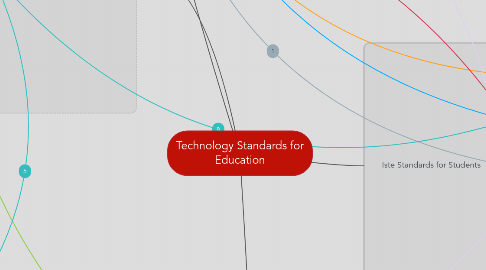Technology Standards for Education
作者:Maya Kay

1. ICT Program of Studies
1.1. 1. Students will access, operate, relay information from a wide variety of technology
1.2. 3. Students will use technology under a moral code
1.3. 2. Students will use technology to interpret and solve problems
1.4. 4. Students understand the main role of technology and how it applies to themselves, others, and society
1.5. 5. Students will use technology to communicate and interact with others.
2. Learning and Technology Policy Framework
2.1. 1. Student Focused Learning-- technology supports students entered learning, students use online and digital learning to enhance comprehension
2.2. 2. Exploration and Innovation-- teachers as well as other educational professionals are expected be proficient in content by reviewing, sharing, and applying their research
2.3. 3. Specialized Learning-- teachers and other education professionals must maintain and administer knowledge and skills that permit them to use technology to their highest potential
2.4. 4. Leadership-- educators establish rules and structure, enhance innovation and focus on student centered learning and enhancing the system
2.5. 5. Access, Infrastructure and Digital Learning Environments-- students, teacher, administrators have access to technological devices, reliable networks and digital learning environments
3. ISTE Standards of Teachers
3.1. 1. Facilitate and Inspire Student Learning and Creativity-- Teachers use knowledge of content, teaching, learning, and technology to enable student comprehension, originality and modernization in face-to-face and virtual environments.
3.2. 2. Design and Develop Digital Age Learning Experiences and Assessments—Teachers will plan, administer, and evaluate accurate learning by including innovative tools and resources to increase content learning to progress the understanding, abilities and attitudes as identified in the ISTE Standards.
3.3. 3. Model Digital Age Work and Learning --Teachers are fluent in their content knowledge, abilities and work processes that are illustrative in a global and digital world.
3.4. 4. Promote and Model Digital Citizenship and Responsibility-- Teachers are aware of societal and global issues and their duty in the advancing digital culture while demonstrating legal and ethical conduct in their professional practices
3.5. 5. Engage in Professional Growth and Leadership—Teachers are always improving their professional practice, by displaying guidance in their schools and professional communities by encouraging and establishing the successful use of digital tools and resources
4. Iste Standards for Students
4.1. 1. Empowered Learner—Students use technology to aid them in taking part in and showing proficiency in achieving their learning outcomes
4.2. 2. Digital Citizen—Students use the digital world to remain connected and act in a safe, legal and moral manner while being conscious of their privileges, obligations and the opportunities they have to learn.
4.3. 3. Knowledge Constructor—Students use their digital resources to create, build and generate creative products that enhance their learning for themselves and others
4.4. 4. Innovative Designer—Students use different technologies and tools to classify and decipher problems by creating new, beneficial or imaginative resolutions.
4.5. 5. Global Collaborator—Students use digital technologies to increase their perspectives and improve their learning by collaborating with others and working efficiently in teams locally and universally


